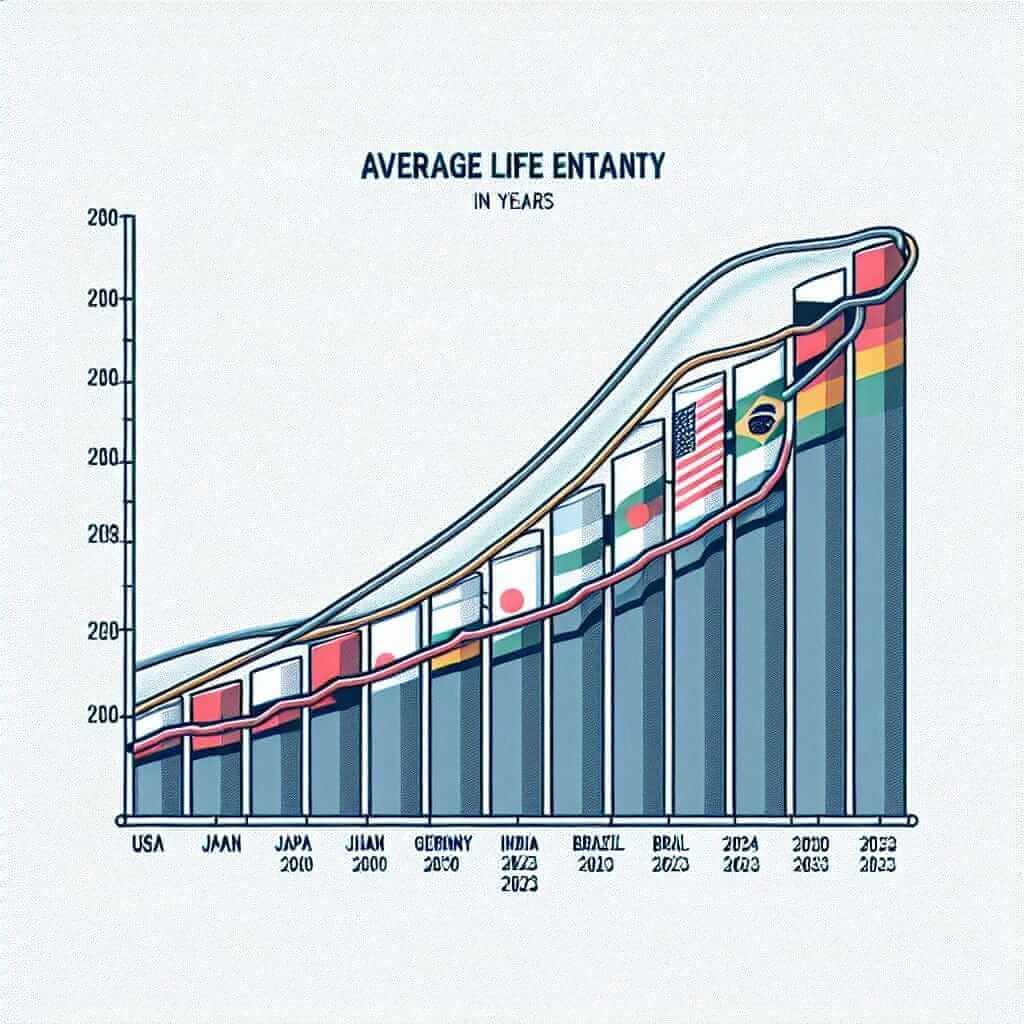Understanding the variation in average lifespan across different countries is a pertinent topic that often appears in the IELTS Writing Task 1. This can take the form of line graphs, bar charts, or tables, requiring test-takers to analyse and describe data trends effectively. In this article, we’ll delve into writing about comparing average lifespan across various countries from 2000 to 2023. We’ll cover strategies, vocabulary, and grammar tips, and I’ll even provide a sample response to an IELTS Writing Task 1 question.
Introduction
When preparing for the IELTS Writing Task 1, it’s crucial to understand the topic and data presented effectively. One recurring theme is the comparison of average lifespan across different nations over a specified period. Below are some sample questions to illustrate how this topic may appear in the exam:
- Compare the average lifespan in various countries between 2000 and 2023.
- Describe the trends in life expectancy in different countries from 2000 to 2023.
- Analyze the changes in average lifespan across selected countries over the years 2000 to 2023.
Let’s select the following prompt for our detailed analysis and sample writing:
Sample Task:
“The following table shows the average lifespan (in years) in selected countries from 2000 to 2023. Summarise the information by selecting and reporting the main features, and make comparisons where relevant.”
We’ll create a mock table for illustration:
| Country | 2000 | 2010 | 2020 | 2023 |
|---|---|---|---|---|
| USA | 76.8 | 78.2 | 79.5 | 80.2 |
| Japan | 82.1 | 83.0 | 84.2 | 85.1 |
| Germany | 77.3 | 78.5 | 79.8 | 80.5 |
| India | 63.3 | 65.8 | 68.7 | 70.1 |
| Brazil | 67.8 | 70.3 | 72.5 | 74.0 |

Data Analysis
Key Observations:
- Overall Increase: All countries show an increase in average lifespan from 2000 to 2023.
- Highest Lifespan: Japan consistently has the highest life expectancy over the years.
- Significant Increase in Developing Countries: India and Brazil exhibit notable increases in life expectancy.
Sample Writing
Below is a sample response to the given task.
The table provides information on the average lifespan in years across five countries—USA, Japan, Germany, India, and Brazil—from 2000 to 2023.
(Introduction 20 words)
Overall, the data reveals a universal upward trend in life expectancy, with Japan consistently leading and developing nations such as India and Brazil showing significant improvements.
(Overview 27 words)
Starting with the data from 2000, Japan had the highest average lifespan at 82.1 years, followed by Germany and the USA at 77.3 and 76.8 years, respectively. In contrast, India and Brazil had significantly lower life expectancies at 63.3 and 67.8 years, respectively.
(Paragraph 1 – 55 words)
By 2010, life expectancy had increased in all countries. Japan saw a modest rise to 83 years, while Germany and the USA followed suit with increases to 78.5 and 78.2 years, respectively. More notably, India and Brazil experienced substantial gains, with their average lifespans rising to 65.8 and 70.3 years.
(Paragraph 2 – 55 words)
In 2020, Japan continued to have the highest lifespan at 84.2 years. The USA and Germany reached 79.5 and 79.8 years correspondingly. The improvements in India and Brazil were more pronounced, with India reaching 68.7 years and Brazil moving closer to the developed world average at 72.5 years.
(Paragraph 3 – 52 words)
By 2023, the trajectory of increasing life expectancy remained consistent across all countries. Japan peaked at 85.1 years, followed by Germany at 80.5 years, and the USA at 80.2 years. India and Brazil continued their upward trends, with life expectancies of 70.1 and 74 years, reflecting significant longitudinal improvements.
(Paragraph 4 – 57 words)
In summary, from 2000 to 2023, all countries observed a notable rise in average lifespan, with Japan maintaining the highest expectancy. Developing nations such as India and Brazil showed the most significant improvements, closing the gap with more developed countries.
(Conclusion 42 words)
Total Word Count: 253 words
Vocabulary and Grammar Tips
Vocabulary:
- Lifespan: (noun) /ˈlaɪf.spæn/ – The length of time for which a person or animal lives.
- Trend: (noun) /trend/ – A general direction in which something is developing or changing.
- Substantial: (adjective) /səbˈstæn.ʃəl/ – Of considerable importance, size, or worth.
- Trajectory: (noun) /trəˈdʒek.tər.i/ – The path followed by a projectile flying or an object moving under the action of given forces.
- Longevity: (noun) /lɒnˈdʒev.ə.ti/ – Long life.
Grammar Tips:
- Comparative Structures: Use comparative adjectives to compare data (e.g., “higher than,” “lower than,” “more significant,” “least/most pronounced”).
- Tenses: Use past simple for data in specific past years and present perfect for general trends from past to present.
Conclusion
For IELTS Writing Task 1, effectively analyzing and summarizing data is crucial. Emphasize key trends, use comparative language, and maintain clarity with a well-structured response. By following these guidelines, you’ll be on the right path to achieving a high band score.